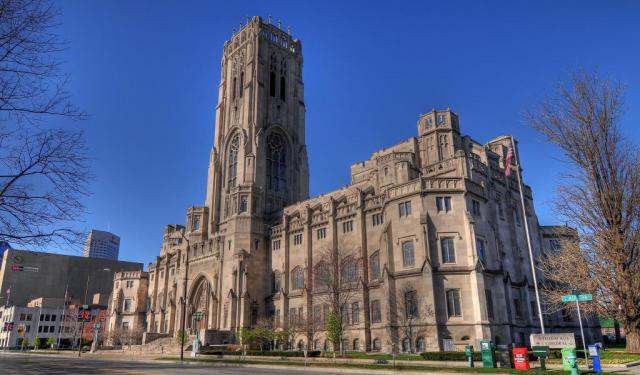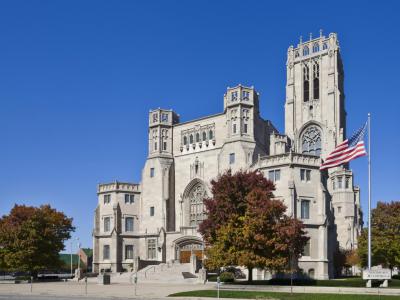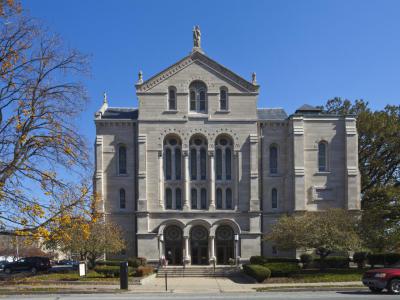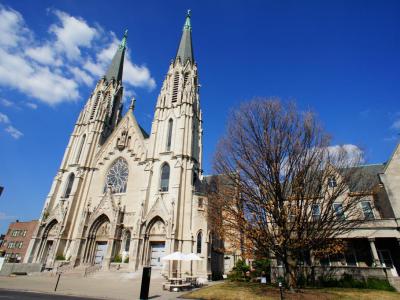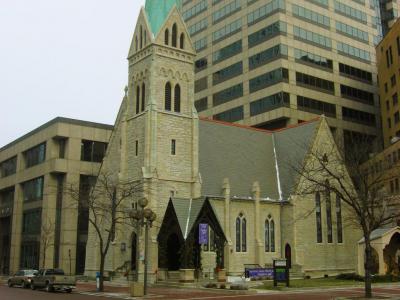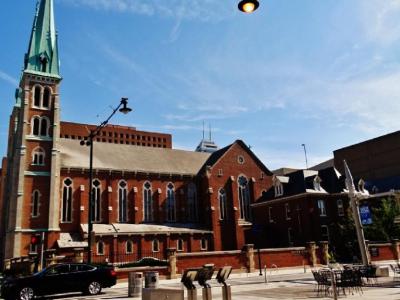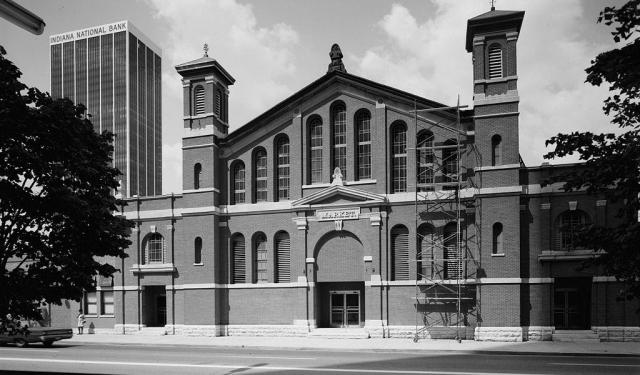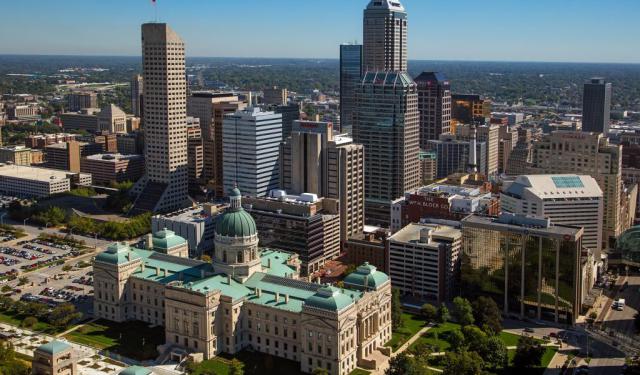Historical Churches Walking Tour (Self Guided), Indianapolis
The rich history of Indianapolis is reflected, among other things, in the extensive collection of historical churches. Throughout decades, these sacred landmarks have influenced the social geography of the city and today serve as symbols of the city's cultural and architectural heritage.
One such is the Scottish Rite Cathedral, a prominent example of Neo-Gothic style, known for its intricate stonework. This cathedral, completed in 1929, serves as a hub for the Scottish Rite Masons and has a grand presence in the city.
Roberts Park United Methodist Church, established in the 1870s, holds the distinction of being one of the city's oldest congregations. The church's Romanesque architecture is a testament to its historical significance in the community.
Another two magnificent pieces of Gothic Revival masonry, Saint Mary's Catholic Church and Christ Church Cathedral, both date back to the 1850s. Saint Mary's towering spires make it a landmark hard to miss, while the imposing architecture of the Christ Church Cathedral has earned it a place on the National Register of Historic Places.
Saint John the Evangelist Catholic Church, completed in 1871, is yet another noteworthy historical temple in the city. Its beautiful French Gothic architecture and stunning interior are a testament to the local religious heritage.
Collectively, these historical churches form an integral part of Indianapolis's identity; their cultural and social significance is hard to overestimate. If you are an architecture buff or simply seeking a place of spiritual solace, consider visiting these cherished locations on our self-guided walking tour.
One such is the Scottish Rite Cathedral, a prominent example of Neo-Gothic style, known for its intricate stonework. This cathedral, completed in 1929, serves as a hub for the Scottish Rite Masons and has a grand presence in the city.
Roberts Park United Methodist Church, established in the 1870s, holds the distinction of being one of the city's oldest congregations. The church's Romanesque architecture is a testament to its historical significance in the community.
Another two magnificent pieces of Gothic Revival masonry, Saint Mary's Catholic Church and Christ Church Cathedral, both date back to the 1850s. Saint Mary's towering spires make it a landmark hard to miss, while the imposing architecture of the Christ Church Cathedral has earned it a place on the National Register of Historic Places.
Saint John the Evangelist Catholic Church, completed in 1871, is yet another noteworthy historical temple in the city. Its beautiful French Gothic architecture and stunning interior are a testament to the local religious heritage.
Collectively, these historical churches form an integral part of Indianapolis's identity; their cultural and social significance is hard to overestimate. If you are an architecture buff or simply seeking a place of spiritual solace, consider visiting these cherished locations on our self-guided walking tour.
How it works: Download the app "GPSmyCity: Walks in 1K+ Cities" from Apple App Store or Google Play Store to your mobile phone or tablet. The app turns your mobile device into a personal tour guide and its built-in GPS navigation functions guide you from one tour stop to next. The app works offline, so no data plan is needed when traveling abroad.
Historical Churches Walking Tour Map
Guide Name: Historical Churches Walking Tour
Guide Location: USA » Indianapolis (See other walking tours in Indianapolis)
Guide Type: Self-guided Walking Tour (Sightseeing)
# of Attractions: 5
Tour Duration: 1 Hour(s)
Travel Distance: 2.8 Km or 1.7 Miles
Author: Sandra
Sight(s) Featured in This Guide:
Guide Location: USA » Indianapolis (See other walking tours in Indianapolis)
Guide Type: Self-guided Walking Tour (Sightseeing)
# of Attractions: 5
Tour Duration: 1 Hour(s)
Travel Distance: 2.8 Km or 1.7 Miles
Author: Sandra
Sight(s) Featured in This Guide:
- Scottish Rite Cathedral
- Roberts Park United Methodist Church
- St. Mary's Catholic Church
- Christ Church Cathedral
- St. John the Evangelist Catholic Church
1) Scottish Rite Cathedral
The Scottish Rite Cathedral was designed by architect George F. Schreiber and plays an essential role in Scottish Rite Freemasonry's life in Indianapolis. This Neo-Gothic building was constructed between 1927 and 1929. Some of the highlights include a 212-foot tower with a carillon known as the "Singing Tower".
Sculptures depicted on the exterior include key figures such as King Solomon and King Hiram. Marble floors at the eastern and southern entrances feature centerpieces with the 12 Zodiac signs. These windows depict important symbolism to Freemasonry, as well as symbolism representing 1920s technology, as well as the liberal arts and sciences.
A ballroom with a floating floor and Elizabethan architecture also has a chandelier with over 200 lights. There is a Cathedral Gothic theater that features over 50 hand-painted backdrops. In addition to taking advantage of tours of this magnificent building, visitors can also stop at the Double Eagle Cafe for lunch.
Sculptures depicted on the exterior include key figures such as King Solomon and King Hiram. Marble floors at the eastern and southern entrances feature centerpieces with the 12 Zodiac signs. These windows depict important symbolism to Freemasonry, as well as symbolism representing 1920s technology, as well as the liberal arts and sciences.
A ballroom with a floating floor and Elizabethan architecture also has a chandelier with over 200 lights. There is a Cathedral Gothic theater that features over 50 hand-painted backdrops. In addition to taking advantage of tours of this magnificent building, visitors can also stop at the Double Eagle Cafe for lunch.
2) Roberts Park United Methodist Church
Roberts Park United Methodist Church, originally known as Roberts Park Methodist Episcopal Church, stands as one of downtown Indianapolis's oldest churches. Dedicated on August 27, 1876, it is a historic example of Romanesque Revival architecture, designed by Diedrich A. Bohlen, a renowned German-born architect who shaped several iconic structures in Indiana. The church, located at Delaware and Vermont Streets, is constructed of Indiana limestone and features a rectangular plan with a prominent three-story bell tower on its southwest corner.
Bohlen's design reflects the Rundbogenstil (round-arch) style, showcasing influences from his German architectural studies. The Delaware Street façade features three sections with repeated round-arched arcades. The central section, highlighted by stained-glass windows and rose windows, is flanked by narrower segments. A gable with stone crosses and a Saint Mary statue crowns the roofline. The bell tower, with its rounded-arch windows and pyramid-shaped roof, remains a distinctive feature despite the unbuilt spire.
The church’s sanctuary is celebrated for its exquisite black-walnut woodwork, particularly the dual staircases leading to galleries that span three sides of the sanctuary. This craftsmanship enhances the timeless beauty of the worship space.
The church traces its origins to 1822 when Indianapolis’s first Methodist congregation formed. After a division in 1842, one group established Roberts Chapel in 1843, named after Methodist Bishop Robert R. Roberts. The decision to construct a new church at its current location followed the Civil War, with construction beginning in 1869 and culminating in 1876 after financial delays. The building was listed on the National Register of Historic Places on August 19, 1982.
Beyond its architectural grandeur, the church is home to one of the Homeless Jesus statues, symbolizing its commitment to social justice and compassion. This statue is located behind the church on Alabama Street.
A 1927 addition at the church's east end maintains the original structure's aesthetic, ensuring continuity in its design and function. Roberts Park United Methodist Church continues to be a spiritual and architectural landmark, embodying over a century of history and service in Indianapolis.
Bohlen's design reflects the Rundbogenstil (round-arch) style, showcasing influences from his German architectural studies. The Delaware Street façade features three sections with repeated round-arched arcades. The central section, highlighted by stained-glass windows and rose windows, is flanked by narrower segments. A gable with stone crosses and a Saint Mary statue crowns the roofline. The bell tower, with its rounded-arch windows and pyramid-shaped roof, remains a distinctive feature despite the unbuilt spire.
The church’s sanctuary is celebrated for its exquisite black-walnut woodwork, particularly the dual staircases leading to galleries that span three sides of the sanctuary. This craftsmanship enhances the timeless beauty of the worship space.
The church traces its origins to 1822 when Indianapolis’s first Methodist congregation formed. After a division in 1842, one group established Roberts Chapel in 1843, named after Methodist Bishop Robert R. Roberts. The decision to construct a new church at its current location followed the Civil War, with construction beginning in 1869 and culminating in 1876 after financial delays. The building was listed on the National Register of Historic Places on August 19, 1982.
Beyond its architectural grandeur, the church is home to one of the Homeless Jesus statues, symbolizing its commitment to social justice and compassion. This statue is located behind the church on Alabama Street.
A 1927 addition at the church's east end maintains the original structure's aesthetic, ensuring continuity in its design and function. Roberts Park United Methodist Church continues to be a spiritual and architectural landmark, embodying over a century of history and service in Indianapolis.
3) St. Mary's Catholic Church
Saint Mary Catholic Church, located at the corner of New Jersey and Vermont Streets in Indianapolis, is a historic Roman Catholic parish within the Archdiocese of Indianapolis. Founded in 1858 to serve the city’s burgeoning German Catholic community, the parish boasts a rich heritage and a landmark church completed in 1912. Recognized on the National Register of Historic Places, the church is a testament to late Gothic Revival architecture, inspired by the grandeur of Cologne Cathedral in Germany.
The parish began in 1856 when Reverend Peter Leonard Brandt arrived to serve Indianapolis's German-speaking Catholics. Under Reverend Simon Siegrist, its first church was built on East Maryland Street in 1858, offering services in Latin and German. In the early 20th century, the parish relocated to New Jersey and Vermont Streets, constructing the current church that honors its Germanic heritage.
Designed by Cologne-born architect Hermann J. Gaul, Saint Mary’s features a cruciform plan with a narthex and semi-octagonal apse. The stone façade is divided into three sections: a gabled central portion with a trefoil motif, a finial, and Virgin Mary statue, and flanking towers crowned with spires. Tympana depicts the Crucifixion, Birth of Christ, and Ascension. Buttresses, vaulted arches, and gargoyles add to its Gothic charm.
The interior features a vaulted ceiling, a semi-octagonal apse, and numerous statues, skylights, and stained-glass windows. Among the notable stained-glass depictions are Saint Boniface, credited with converting the Germans to Christianity, and Saint Henry of Uppsala, honored as a "church builder." The sanctuary’s intricate art glass windows and ornate details create a serene and spiritually uplifting atmosphere.
Saint Mary Catholic Church remains a cherished landmark in Indianapolis, celebrated for its architectural splendor and enduring legacy as a vibrant center of faith and community.
The parish began in 1856 when Reverend Peter Leonard Brandt arrived to serve Indianapolis's German-speaking Catholics. Under Reverend Simon Siegrist, its first church was built on East Maryland Street in 1858, offering services in Latin and German. In the early 20th century, the parish relocated to New Jersey and Vermont Streets, constructing the current church that honors its Germanic heritage.
Designed by Cologne-born architect Hermann J. Gaul, Saint Mary’s features a cruciform plan with a narthex and semi-octagonal apse. The stone façade is divided into three sections: a gabled central portion with a trefoil motif, a finial, and Virgin Mary statue, and flanking towers crowned with spires. Tympana depicts the Crucifixion, Birth of Christ, and Ascension. Buttresses, vaulted arches, and gargoyles add to its Gothic charm.
The interior features a vaulted ceiling, a semi-octagonal apse, and numerous statues, skylights, and stained-glass windows. Among the notable stained-glass depictions are Saint Boniface, credited with converting the Germans to Christianity, and Saint Henry of Uppsala, honored as a "church builder." The sanctuary’s intricate art glass windows and ornate details create a serene and spiritually uplifting atmosphere.
Saint Mary Catholic Church remains a cherished landmark in Indianapolis, celebrated for its architectural splendor and enduring legacy as a vibrant center of faith and community.
4) Christ Church Cathedral
Christ Church Cathedral, the seat of the Episcopal Diocese of Indianapolis, stands as a testament to faith, history, and architectural beauty. Located on Monument Circle in the heart of downtown Indianapolis, this English Gothic Revival masterpiece, designed by Irish architect William Tinsley, was built in 1857 and is the oldest continuously used church building in Indianapolis and Marion County. It is also the oldest structure on Monument Circle.
The church, constructed to replace the parish's first building on the same site, features hallmark Gothic elements such as tall windows, a peaked roof, and an octagonal spire crowned with the Greek letters Chi and Rho. Originally faced in red brick, the exterior was later clad in limestone. Over the years, the building has undergone several renovations, with significant updates in 1900, 1927, 1954, and beyond, ensuring it remains both functional and true to its architectural heritage.
Inside, the church boasts an elegant white marble altar, leaded-glass windows, and intricate stained glass, including a "Resurrection" window and a series depicting the church's history. Its wooden chancel screen and red-painted inner doors add to the spiritual ambiance. The church is renowned for its professional Choir of Men and Boys and Girls' Choir, as well as its pipe organs, one of which was generously donated by Ruth Lilly.
Beyond its architectural and musical achievements, Christ Church Cathedral is deeply committed to community service. Its annual Strawberry Festival is a beloved tradition that supports charitable initiatives. The church's dedication to urban ministry has been recognized since the 1960s, highlighting its role as both a cathedral and a community parish.
Christ Church Cathedral was consecrated as a pro-cathedral in 1954 and added to the National Register of Historic Places in 1973. As a landmark within the Washington Street-Monument Circle Historic District, it remains a beacon of faith, history, and civic engagement in Indianapolis.
The church, constructed to replace the parish's first building on the same site, features hallmark Gothic elements such as tall windows, a peaked roof, and an octagonal spire crowned with the Greek letters Chi and Rho. Originally faced in red brick, the exterior was later clad in limestone. Over the years, the building has undergone several renovations, with significant updates in 1900, 1927, 1954, and beyond, ensuring it remains both functional and true to its architectural heritage.
Inside, the church boasts an elegant white marble altar, leaded-glass windows, and intricate stained glass, including a "Resurrection" window and a series depicting the church's history. Its wooden chancel screen and red-painted inner doors add to the spiritual ambiance. The church is renowned for its professional Choir of Men and Boys and Girls' Choir, as well as its pipe organs, one of which was generously donated by Ruth Lilly.
Beyond its architectural and musical achievements, Christ Church Cathedral is deeply committed to community service. Its annual Strawberry Festival is a beloved tradition that supports charitable initiatives. The church's dedication to urban ministry has been recognized since the 1960s, highlighting its role as both a cathedral and a community parish.
Christ Church Cathedral was consecrated as a pro-cathedral in 1954 and added to the National Register of Historic Places in 1973. As a landmark within the Washington Street-Monument Circle Historic District, it remains a beacon of faith, history, and civic engagement in Indianapolis.
5) St. John the Evangelist Catholic Church
Saint John the Evangelist Catholic Church, located in downtown Indianapolis, is a historic and architectural treasure of the Archdiocese of Indianapolis. Founded in 1837 as Holy Cross Parish, it was renamed in 1850 and is the oldest Catholic parish in both Indianapolis and Marion County. Often referred to as the "mother" of Catholic parishes in the city, Saint John’s played a pivotal role in the establishment and growth of the Catholic Church in the region.
Between 1878 and 1906, Saint John’s functioned as the diocese's pro-cathedral. Its rectory served dual roles as the bishop’s residence and the diocesan chancery during that period. In 1900, the church hosted the first episcopal consecration held in Indianapolis, further solidifying its place in local ecclesiastical history. Despite its unofficial status as a cathedral, Saint John’s served many diocesan purposes until Saints Peter and Paul Cathedral was completed in 1906.
The parish’s influence extended well into the 20th century, with its rectory housing the diocesan chancery until 1968 and serving as the metropolitan tribunal until 1982. Both the church and rectory were added to the National Register of Historic Places in 1980.
The current Saint John’s Church, the parish's third structure, occupies a prominent position at the corner of Georgia Street and Capitol Avenue. Designed by Diedrich A. Bohlen, a prominent Indianapolis architect, the red-brick building was constructed between 1867 and 1871. Bohlen also designed the rectory (1863) and its later addition (1878). His son, Oscar Bohlen, designed the church’s twin spires, completed in 1893.
Architecturally, the church is an eclectic masterpiece combining elements of French Gothic Revival and American Romanesque Revival styles. Its sanctuary, with a seating capacity of 3,000, was the largest in Indiana when the cornerstone was laid in 1867. The church was officially dedicated on July 2, 1871. Whether as a place of worship or a monument to the city's Catholic roots, Saint John’s continues to inspire awe and devotion.
Between 1878 and 1906, Saint John’s functioned as the diocese's pro-cathedral. Its rectory served dual roles as the bishop’s residence and the diocesan chancery during that period. In 1900, the church hosted the first episcopal consecration held in Indianapolis, further solidifying its place in local ecclesiastical history. Despite its unofficial status as a cathedral, Saint John’s served many diocesan purposes until Saints Peter and Paul Cathedral was completed in 1906.
The parish’s influence extended well into the 20th century, with its rectory housing the diocesan chancery until 1968 and serving as the metropolitan tribunal until 1982. Both the church and rectory were added to the National Register of Historic Places in 1980.
The current Saint John’s Church, the parish's third structure, occupies a prominent position at the corner of Georgia Street and Capitol Avenue. Designed by Diedrich A. Bohlen, a prominent Indianapolis architect, the red-brick building was constructed between 1867 and 1871. Bohlen also designed the rectory (1863) and its later addition (1878). His son, Oscar Bohlen, designed the church’s twin spires, completed in 1893.
Architecturally, the church is an eclectic masterpiece combining elements of French Gothic Revival and American Romanesque Revival styles. Its sanctuary, with a seating capacity of 3,000, was the largest in Indiana when the cornerstone was laid in 1867. The church was officially dedicated on July 2, 1871. Whether as a place of worship or a monument to the city's Catholic roots, Saint John’s continues to inspire awe and devotion.
Walking Tours in Indianapolis, Indiana
Create Your Own Walk in Indianapolis
Creating your own self-guided walk in Indianapolis is easy and fun. Choose the city attractions that you want to see and a walk route map will be created just for you. You can even set your hotel as the start point of the walk.
Architectural Jewels
A number of unique constructions found throughout Indianapolis have given the city its inimitable identity. Many of them are registered on the National Register of Historic Places.
Some of the best local buildings are situated along the diagonal avenues coming from Mile Square, as per the city plan laid out in 1821 by Scottish-born architect Alexander Ralston (the one who participated in laying... view more
Tour Duration: 2 Hour(s)
Travel Distance: 4.6 Km or 2.9 Miles
Some of the best local buildings are situated along the diagonal avenues coming from Mile Square, as per the city plan laid out in 1821 by Scottish-born architect Alexander Ralston (the one who participated in laying... view more
Tour Duration: 2 Hour(s)
Travel Distance: 4.6 Km or 2.9 Miles
Indianapolis Introduction Walking Tour
The "Crossroads of America", Indianapolis (or Indy for short) is the capital of the US state of Indiana and the heart of the American Midwest.
The Indigenous people had lived in this area since as early as 10,000 BC before they relinquished their tribal land to the United States, in the Treaty of Saint Mary's, in 1818. The Eiteljorg Museum of American Indians and Western Art in... view more
Tour Duration: 2 Hour(s)
Travel Distance: 4.5 Km or 2.8 Miles
The Indigenous people had lived in this area since as early as 10,000 BC before they relinquished their tribal land to the United States, in the Treaty of Saint Mary's, in 1818. The Eiteljorg Museum of American Indians and Western Art in... view more
Tour Duration: 2 Hour(s)
Travel Distance: 4.5 Km or 2.8 Miles
The Most Popular Cities
/ view all
